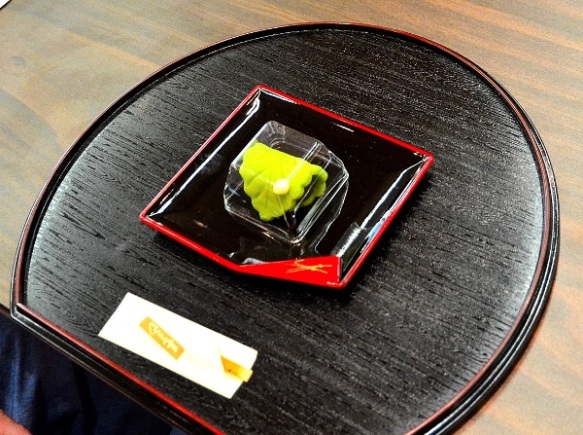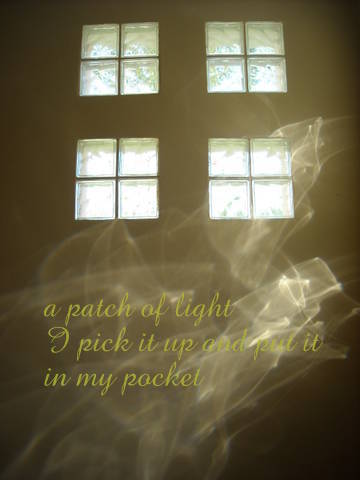What a magic meeting yesterday!
 This was the twelfth year we have held our Spring meeting at the Embassy! Mr. Toshi Yonehara and Ms. Chisa Takiguchi greeted us, and we began with a gift of haiku magazines from Japan for KaDo members from the Embassy, the introductions of guests, and regrets from Lana Holmes who was not feeling well.
This was the twelfth year we have held our Spring meeting at the Embassy! Mr. Toshi Yonehara and Ms. Chisa Takiguchi greeted us, and we began with a gift of haiku magazines from Japan for KaDo members from the Embassy, the introductions of guests, and regrets from Lana Holmes who was not feeling well.
We just had to take time to admire Heather MacDonald’s beautiful brush paintings, of gladiolus for the agenda, and ‘kindheartedness’ on the broadsheet, Stuffing the Feeder, which was read next. These broadsheets become, because of her paintings, works of art as well as collections of poetry. The broadsheet was edited this year by Grant D. Savage, and produced by Mike Montreuil. During the reading Grant inserted extra poems that he would have liked to have been able to include because they were such good haiku.
These broadsheets become, because of her paintings, works of art as well as collections of poetry. The broadsheet was edited this year by Grant D. Savage, and produced by Mike Montreuil. During the reading Grant inserted extra poems that he would have liked to have been able to include because they were such good haiku. 
This is where Grant would have, if he could have, added these haiku: Following immediately after Heather MacDonald’s “scent of straw”, Terry’s
february blahs/i change the pillowcases/ to red
Following immediately after “long stemmed roses” by Terry Ann, a haiku by Lana Holmes:
i drift
snow drifts
hot saki
and following immediately after Gill Foss’s haiku, “my world”
Marco’s: a photograph/of sand/sticking to her body
Thank you Grant and Mike.
Next on the agenda: books – Mike Montreuil’s press, Éditions des petits nuages, published l’estuaire entre nos doutes: tankas de chez nous, an anthology of tanka in French by Montreal poets, edited by Maxianne Berger; Tommy Knockers, the Mineral Point Retreat Anthology, edited by Mike Montreuil, and A Thousand Fireflies: Milles Lucioles, tanka by Luminita Suse, translated by Mike, beautifully presented by Luminita, with Mike reading a couple of the translated poems. He also talked about another publication he translated, comme une étoile filante: like a shooting star, by Micheline Beaudry, Bondi Studios. Anne Marie Labelle, who had come from Montreal with Angela Leuck, Steve Luxton and Pamela Cooper, talked about her book, Ma lumière est une ombre / My Sunshine is a Shadow, English translation by Blanca Baquero, about the adoption of her daughter, and illustrated with her daughter Lovita’s drawings. Anne Marie also works at times with Mike on translations; she is an actress, which made for a great presentation. Terry Ann talked about Day Moon Rising, Black Moss Press, focusing in her poems on her work in Cambodia with the Tabitha Foundation, and the children caught in child prostitution. These are lyric poems, with inclusions of haiku and tanka. She commented that it was such a great step to have haiku considered part of a Canadian mainstream poetry publication. She also mentioned her newest book, Allelulia!, haiku and tanka translated by Montreuil, Buschek Books, which will be launched on June 6th. (More news later on the launch.) Masud Taj, poet/architect, showed us his book, Nari Gandi, published by The Foundation for Architecture, Mumbai (with wooden covers!), a copy of which is in the Carleton University Library’s Special Collection. He gave us a few memorized poems, (all of his poetry is memorized) told the story of a connection with a well-known reclusive architect in India and how it led to the manuscript, and showed the book with the poems in his own calligraphy. His short poems seem very like haiku in breath and spirit. He said a few words also about his Alphabestiary: A Poetry Emblem Book by Taj and Bruce Meyer, Exile Editions, Toronto, a book for which Guy Simser expressed great admiration.
We began two rounds of sharing our own haiku, which continued later while we drank tea. Several poets had written special poems in Terry’s honour, and spoke of how they will miss her when she moves to the Victoria area. (Meanwhile Steve Luxton of DC Books, Montreal, sneaked in and sat on the steps behind us…)
Our special presenter was Shinobu Sakane who studied Japanese Literature & Culture and the Teaching of Calligraphy at Toyo University, focusing on the History of Japanese culture. She studied Wagashi cooking at several professional schools in Japan and has developed her own recipes. She now teaches cooking and history to the teachers of Sencha-do in Shizouka and Tokyo.
 Shinobu arranged for Sawa to present the story of wagashi to us. Meanwhile Shinobu and Chiho offered, on special trays, a piece of wagashi to each of us. So delicate and colourful, they were presented on lacquered wooden squares; everyone who had a camera took close-up photos. Sawa told us how a certain small candy wagashi was made, the sugar continuously ‘stirred’ for about two weeks until it formed around a grain of rice; samples were passed around.
Shinobu arranged for Sawa to present the story of wagashi to us. Meanwhile Shinobu and Chiho offered, on special trays, a piece of wagashi to each of us. So delicate and colourful, they were presented on lacquered wooden squares; everyone who had a camera took close-up photos. Sawa told us how a certain small candy wagashi was made, the sugar continuously ‘stirred’ for about two weeks until it formed around a grain of rice; samples were passed around.  (I don’t have a photo of these candies, but Pearl Pirie has a goood pic on her website. Sawa spoke too, of a time in Japan before sugar existed, when sweets cam from fruit. Today sugar is used. Sawa then linked each perfectly molded wagashi shape with either the waka of Heian times, which we have been calling tanka, or the haiku of later times. There was a story for each piece.
(I don’t have a photo of these candies, but Pearl Pirie has a goood pic on her website. Sawa spoke too, of a time in Japan before sugar existed, when sweets cam from fruit. Today sugar is used. Sawa then linked each perfectly molded wagashi shape with either the waka of Heian times, which we have been calling tanka, or the haiku of later times. There was a story for each piece.  Apart from their beauty and appropriateness to occasion and season, they were delicious! Green tea made from leaves, not powder, was served in delicate cups which matched the trays. Every part of the presentation was exceptionally beautiful, and inspired haiku that were read out while we drank our tea.
Apart from their beauty and appropriateness to occasion and season, they were delicious! Green tea made from leaves, not powder, was served in delicate cups which matched the trays. Every part of the presentation was exceptionally beautiful, and inspired haiku that were read out while we drank our tea. 
A haiku and tanka from Grant:
may afternoon/and this sweetest of/Wagashi chrysanthemums
spring at the embassy/the Wagashi/sweet yes/but oh from her mouth/a taste of the culture
We thanked Shinobu Sakane, Sawa and Chiho. On their way out, Terry gave them copies of Day Moon Rising.  I want to thank Terry for her thoughtful gift of a silver elephant from Cambodia. She and I have a little ‘elephant’ history going on, which was extended later in the evening. Read on… We owe many thanks to The Embassy of Japan, to Mr. Toshi Yonehara and Ms. Chisa Takiguchi for extending the time for the meeting this time so we could fully enjoy this most unforgettable afternoon. Afterwards ten of us went to The Blue Cactus – great food, great conversations with Mike Luminita, Terry, Sandra, Brendan, Pamela and Anne Marie, Steve, and Angela. We celebrated the two weddings coming up, Angela and Steve, and Sandra and Brendan, both on the same day, June 30th!!!
I want to thank Terry for her thoughtful gift of a silver elephant from Cambodia. She and I have a little ‘elephant’ history going on, which was extended later in the evening. Read on… We owe many thanks to The Embassy of Japan, to Mr. Toshi Yonehara and Ms. Chisa Takiguchi for extending the time for the meeting this time so we could fully enjoy this most unforgettable afternoon. Afterwards ten of us went to The Blue Cactus – great food, great conversations with Mike Luminita, Terry, Sandra, Brendan, Pamela and Anne Marie, Steve, and Angela. We celebrated the two weddings coming up, Angela and Steve, and Sandra and Brendan, both on the same day, June 30th!!!  Afterwards Sandra and Brendan, Terry and I went back to the Embassy for a screening of a film about women survivors of the tsunami and how they are doing a year later. In 3.11– In the Moment, we saw footage of the wave hitting the reactors at Fukushima taken from the Fukushima television offices which were very close to where the wave hit. There was footage also of the studio itself shaking, computers and files sliding, and some of the panic in the newsroom as the tsunami hit. Director Kyoko Gasha from New York, talked about making the film in only two weeks, with the main focus on women’s experiences. This is another ‘elephant’ moment between Terry and me, as we watched the women making elephants out of towels, which have become a symbol of hope, and which are sold to raise relief funds.This is only the first in a series; the screenings are free, and open to the public, but seats must be reserved. The next will be shown on May 15th at 7 pm. The evening is called Can You See Our Lights, and comprises two films: The First Festival after the Tsunami, and Setting Sail From the Ruins.
Afterwards Sandra and Brendan, Terry and I went back to the Embassy for a screening of a film about women survivors of the tsunami and how they are doing a year later. In 3.11– In the Moment, we saw footage of the wave hitting the reactors at Fukushima taken from the Fukushima television offices which were very close to where the wave hit. There was footage also of the studio itself shaking, computers and files sliding, and some of the panic in the newsroom as the tsunami hit. Director Kyoko Gasha from New York, talked about making the film in only two weeks, with the main focus on women’s experiences. This is another ‘elephant’ moment between Terry and me, as we watched the women making elephants out of towels, which have become a symbol of hope, and which are sold to raise relief funds.This is only the first in a series; the screenings are free, and open to the public, but seats must be reserved. The next will be shown on May 15th at 7 pm. The evening is called Can You See Our Lights, and comprises two films: The First Festival after the Tsunami, and Setting Sail From the Ruins.















